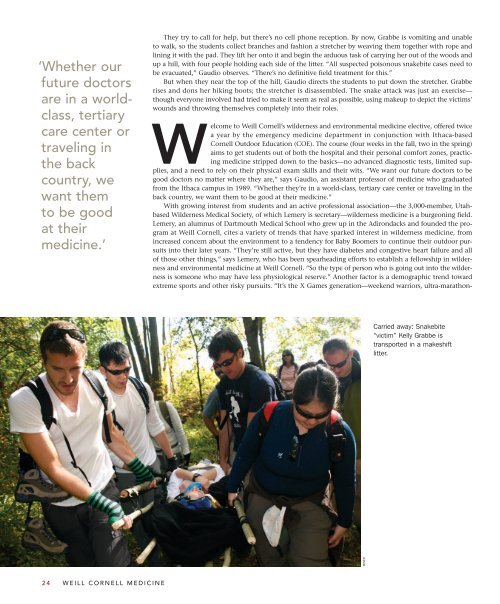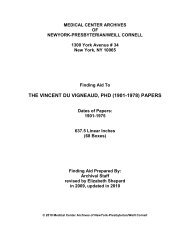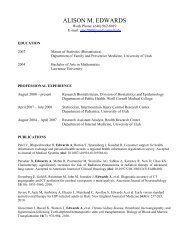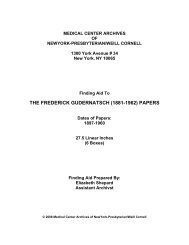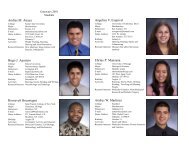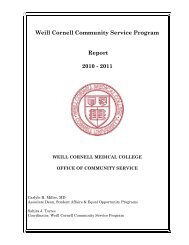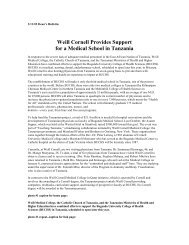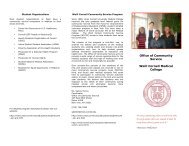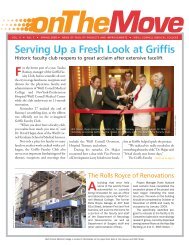Weillcornellmedicine - Weill Medical College - Cornell University
Weillcornellmedicine - Weill Medical College - Cornell University
Weillcornellmedicine - Weill Medical College - Cornell University
Create successful ePaper yourself
Turn your PDF publications into a flip-book with our unique Google optimized e-Paper software.
‘Whether our<br />
future doctors<br />
are in a worldclass,<br />
tertiary<br />
care center or<br />
traveling in<br />
the back<br />
country, we<br />
want them<br />
to be good<br />
at their<br />
medicine.’<br />
24 WEILL CORNELL MEDICINE<br />
They try to call for help, but there’s no cell phone reception. By now, Grabbe is vomiting and unable<br />
to walk, so the students collect branches and fashion a stretcher by weaving them together with rope and<br />
lining it with the pad. They lift her onto it and begin the arduous task of carrying her out of the woods and<br />
up a hill, with four people holding each side of the litter. “All suspected poisonous snakebite cases need to<br />
be evacuated,” Gaudio observes. “There’s no definitive field treatment for this.”<br />
But when they near the top of the hill, Gaudio directs the students to put down the stretcher. Grabbe<br />
rises and dons her hiking boots; the stretcher is disassembled. The snake attack was just an exercise—<br />
though everyone involved had tried to make it seem as real as possible, using makeup to depict the victims’<br />
wounds and throwing themselves completely into their roles.<br />
Welcome to <strong>Weill</strong> <strong>Cornell</strong>’s wilderness and environmental medicine elective, offered twice<br />
a year by the emergency medicine department in conjunction with Ithaca-based<br />
<strong>Cornell</strong> Outdoor Education (COE). The course (four weeks in the fall, two in the spring)<br />
aims to get students out of both the hospital and their personal comfort zones, practicing<br />
medicine stripped down to the basics—no advanced diagnostic tests, limited supplies,<br />
and a need to rely on their physical exam skills and their wits. “We want our future doctors to be<br />
good doctors no matter where they are,” says Gaudio, an assistant professor of medicine who graduated<br />
from the Ithaca campus in 1989. “Whether they’re in a world-class, tertiary care center or traveling in the<br />
back country, we want them to be good at their medicine.”<br />
With growing interest from students and an active professional association—the 3,000-member, Utahbased<br />
Wilderness <strong>Medical</strong> Society, of which Lemery is secretary—wilderness medicine is a burgeoning field.<br />
Lemery, an alumnus of Dartmouth <strong>Medical</strong> School who grew up in the Adirondacks and founded the program<br />
at <strong>Weill</strong> <strong>Cornell</strong>, cites a variety of trends that have sparked interest in wilderness medicine, from<br />
increased concern about the environment to a tendency for Baby Boomers to continue their outdoor pursuits<br />
into their later years. “They’re still active, but they have diabetes and congestive heart failure and all<br />
of those other things,” says Lemery, who has been spearheading efforts to establish a fellowship in wilderness<br />
and environmental medicine at <strong>Weill</strong> <strong>Cornell</strong>. “So the type of person who is going out into the wilderness<br />
is someone who may have less physiological reserve.” Another factor is a demographic trend toward<br />
extreme sports and other risky pursuits. “It’s the X Games generation—weekend warriors, ultra-marathon-<br />
MINER<br />
Carried away: Snakebite<br />
“victim” Kelly Grabbe is<br />
transported in a makeshift<br />
litter.


